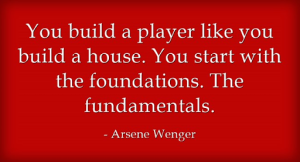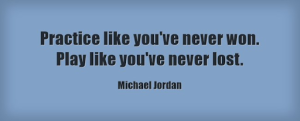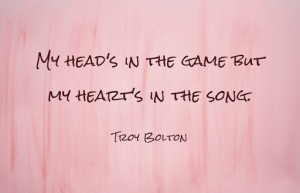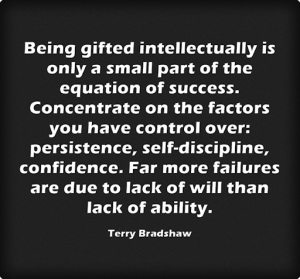Get Your Head in the (Lecture) Game
By Alyssa, a Peer Tutor
My first-ever college lecture was practically a rite of passage. I spent fifty straight minutes trying to simultaneously fight off exhaustion and absorb a barrage of unfamiliar concepts and equations.
Most of my classes haven’t been as grueling as that first 8:00 AM STEM lecture my freshman year. Even so, lectures still present a variety of challenges ranging from zoning out, to falling behind while taking notes, to struggling to keep up with large amounts of difficult new content.
Staring down my latest opponent, a “chill” senior schedule featuring 8:00 AM STEM lectures and several classes lasting well over two hours, now seems like the perfect time to revisit my best (and worst) lecture habits—including how I prep, how I take notes and stay focused, and how I review afterwards. As my high school soccer coach always said, “practice makes perfect,” and believe me…I have had plenty of practice when it comes to getting the most out of lecture.
Pregame
Taking good notes and understanding the material during lecture is always a lot tougher if I go in unprepared. I’ve figured out that recommended textbook readings and pre-class practice questions provide a great scaffold to prepare for lecture. I schedule reading assignments and pre-class assignments into my Google calendar just like any graded homework or test. The amount of time I spend previewing the material varies from class to class, but I try to finish any recommended readings or practice questions the evening before the corresponding lecture. These readings and problems are the perfect “stretch” I need before going to lecture.
For classes that use guided reading questions, I usually try to read the textbook thoroughly and answer questions as I go. When the pre-class questions are calculation-based, I try to work through the problems using the textbook as a reference. If the professor releases lecture slides in advance, I skim through the key points on each slide and print out any diagrams that I may want to take handwritten notes on. These strategies give me a good sneak peek at the upcoming lecture so I can start identifying key concepts and potential hurdles to look out for.
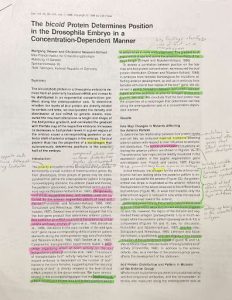
Article Source: Driever W, Nüsslein-Volhard C. The bicoid protein determines position in the Drosophila embryo in a concentration-dependent manner. Cell. 1988;54(1):95-104. doi:10.1016/0092-8674(88)90183-3
As the semester goes on, I usually get a better feel for how intense my pre-lecture prep needs to be for each class. Then, I can decide which textbook readings to skim, what problem sets to spend more time on, etc. For example, in my organic chemistry classes, I usually started my pregame by skimming the textbook, stopping to examine important diagrams and complete in-text practice problems. I then moved on to assigned pre-class practice questions and worked through how to analyze reactants and products and draw reaction mechanisms. With some breaks in between to let me digest new concepts, that pregame routine typically took about an hour and made me feel a lot more prepared heading into lecture the next day.
Game Time
Once I’ve finished my pregame routine, it’s time to plot out my game-time strategy. The first hurdle: picking a format for lecture notes. For most classes, I prefer to take handwritten notes because it improves my retention of new material. Writing out equations and drawing diagrams encourages me to work through problems and processes on my own to make sure I actually understand them. Handwriting notes with a pen and paper also lets me put away all of my electronic devices, which helps me avoid digital distractions like checking texts and emails, getting distracted by unrelated websites, or working on assignments for other classes.
If the professor moves too quickly for me to take good, comprehensive handwritten notes or the lesson focuses on something like computer programming, I often choose to type notes on my laptop. I typically use a Google doc or a blank file for whatever programming language I’m working in. When possible, I set up my playbook using the lecture slides or note templates provided by my professor. For instance, one of my recent statistics courses provided a lecture outline with all of the datasets and main concepts that would be covered in each class. I used that outline to format my R notebook at the start of the lecture, which let me focus on filling in code and making notes on confusing concepts during the lecture itself.
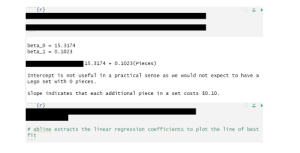
Staying in the Zone
For me, the hardest part of the lecture is rarely coming up with a game-winning strategy—it’s sticking to it. Staying focused can be a challenge, even if the lecture covers topics that interest me and doesn’t last for hours.
To avoid the worst distractions, I put my phone in my backpack and mute notifications on my smartwatch. If my laptop becomes a distraction, I close down all windows except for my notes and, if necessary, try taking notes by hand instead.
If I still keep zoning out even after trying to limit distractions, it’s time to leverage my pregame prep. I’ll use the areas of difficulty I took mental notes of during the pregame to figure out what parts of the lecture require more attention. If parts of the lecture cover more familiar content, I take a step back from my notes and just listen to the lecture to give my brain a bit of a break. Attention is a limited resource, so giving myself a quick time-out lets me refresh my mind and get ready to play hard when I need to get back in the game.
Postgame
A solid game plan for lecture won’t get me far without a good follow-up. Like competitive athletes rewatching film from the game, I review my notes after the lecture by skimming through and mentally summarizing the main ideas and important steps for new types of problems. I then make a game plan to shore up areas of lingering confusion by referring to my textbook, online resources, and peers. I also put together a long-term strategy to reinforce and practice what I learned later, which involves making good use of homework assignments, practice problems, flashcards, diagrams, and any other relevant tools at my disposal.
Just like the 1970’s Steelers Dynasty, a perfect lecture routine isn’t something you can build overnight. Do your best to make use of all your resources, shore up your weak points, focus on the end goal, and—most importantly—keep your head in the game.


